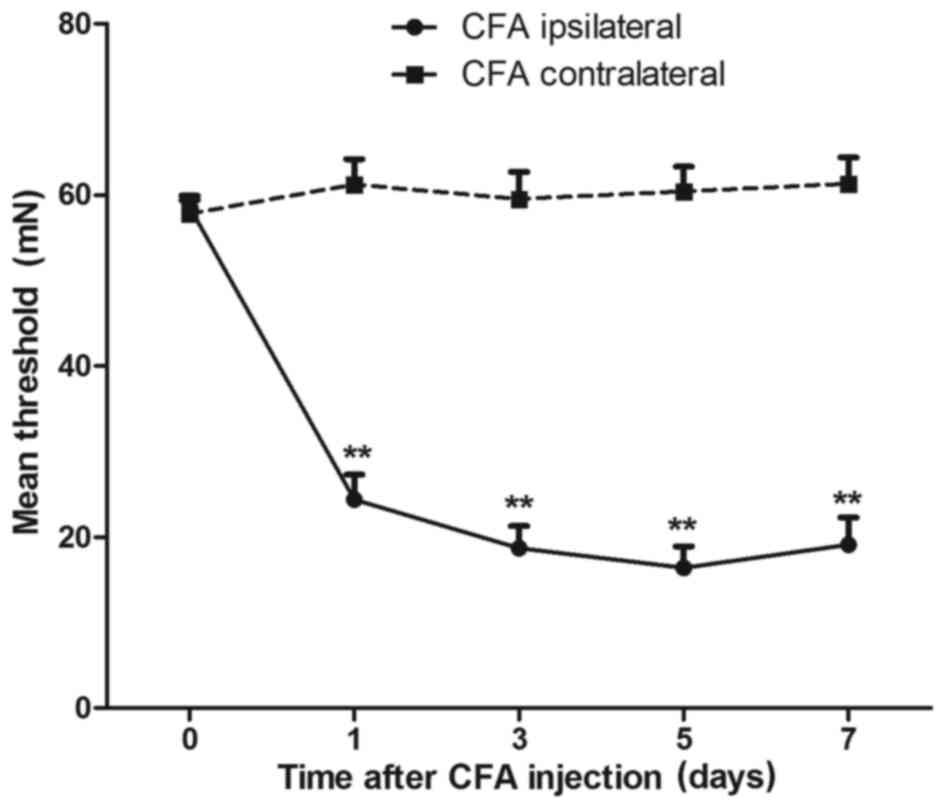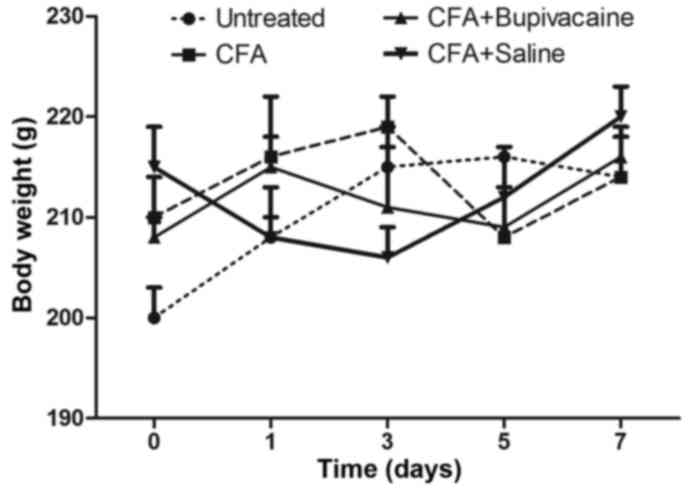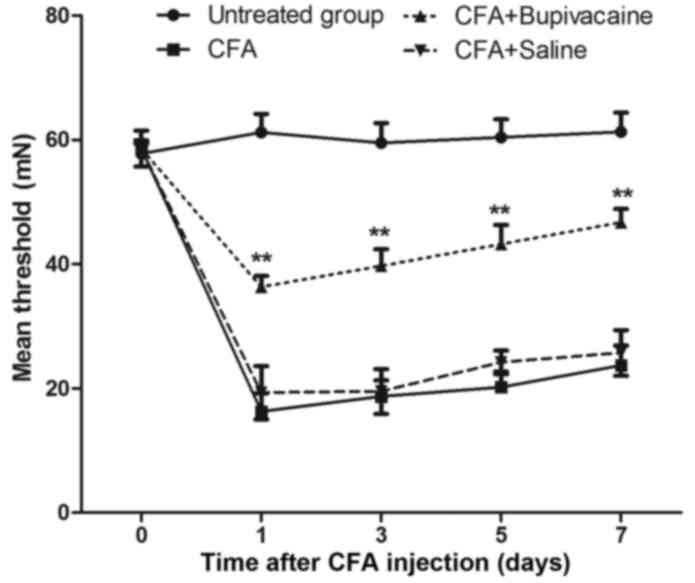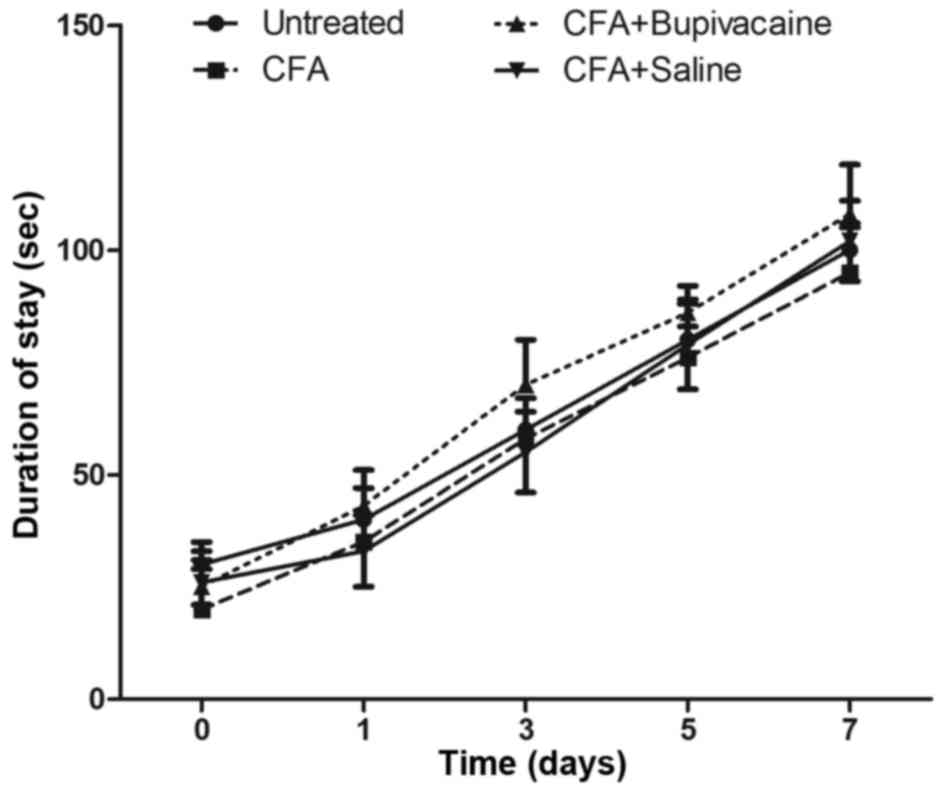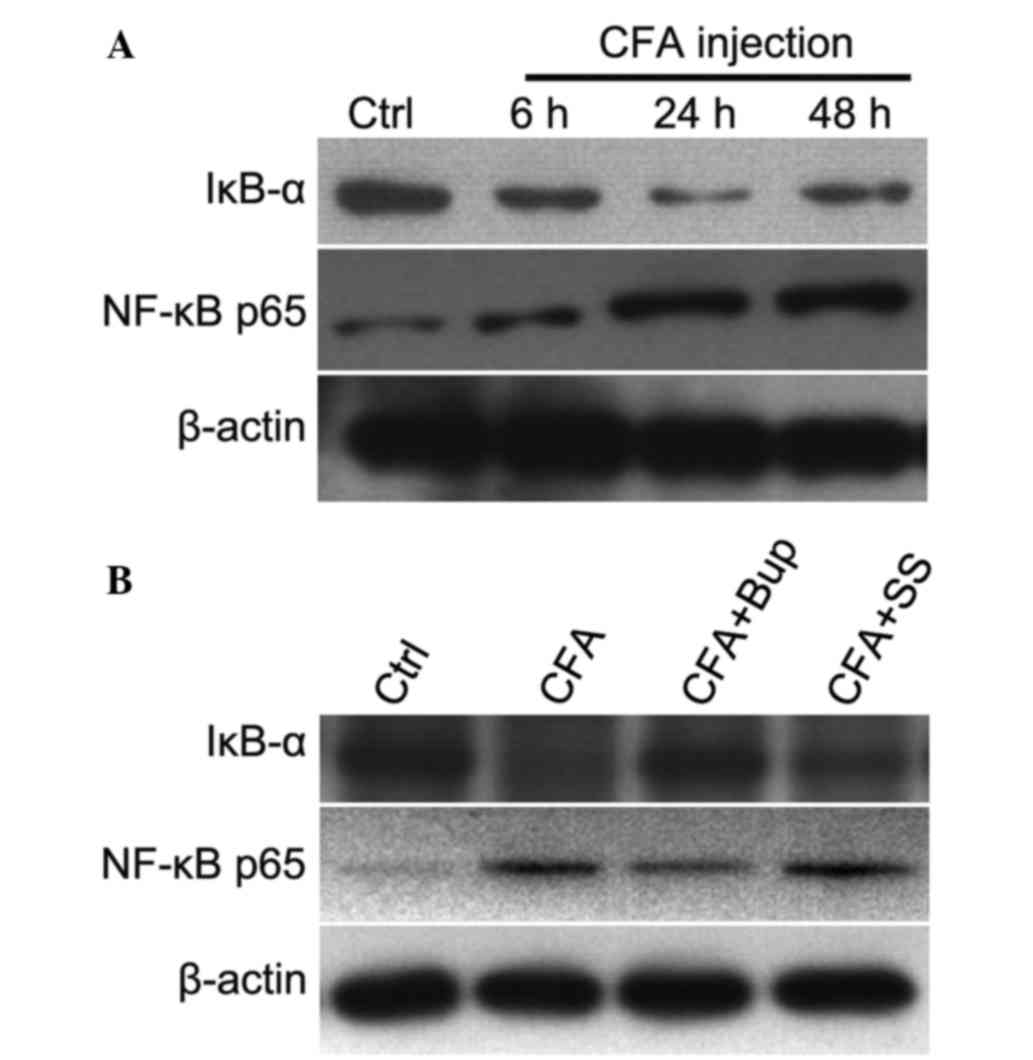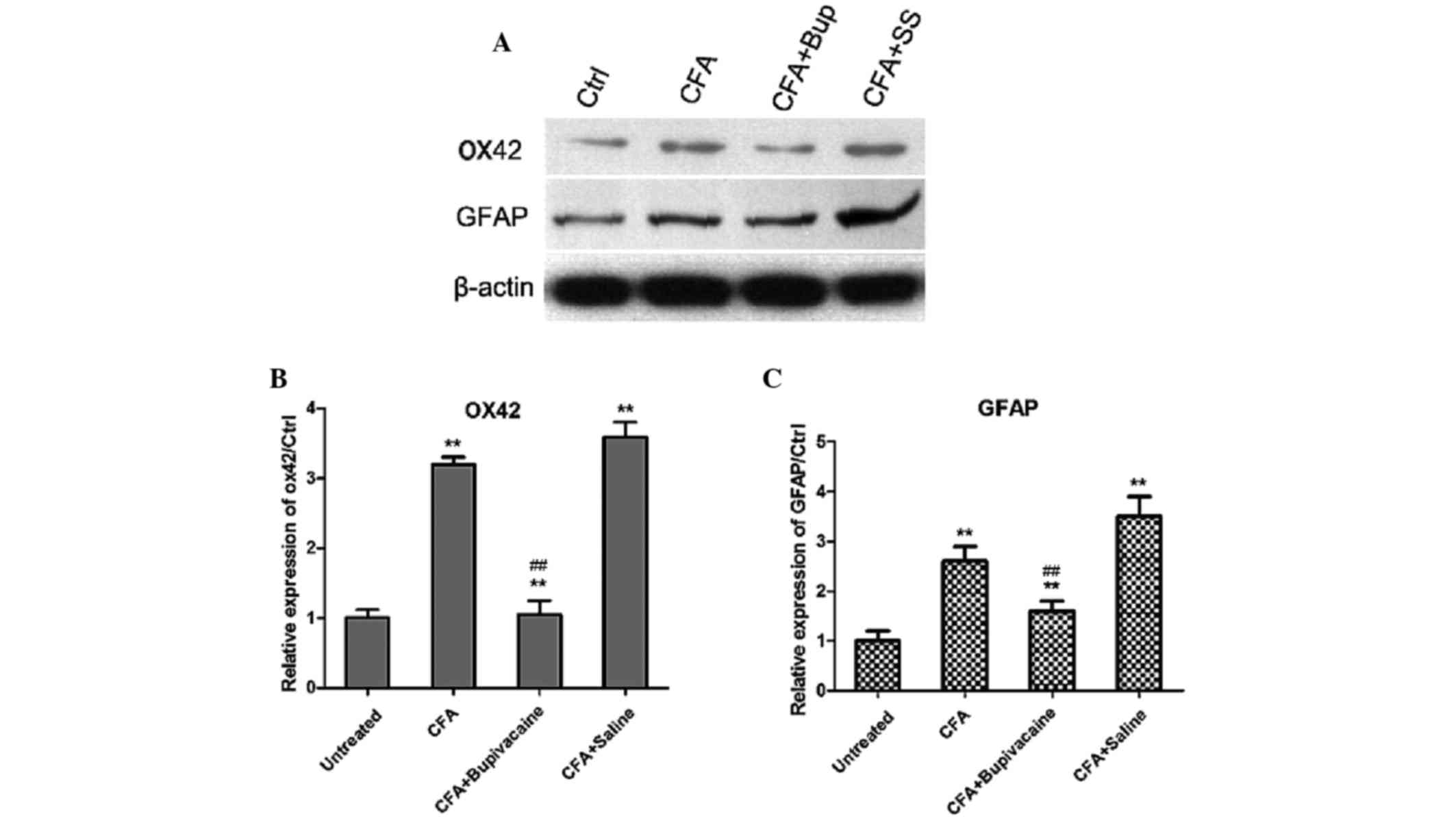Bupivacaine effectively relieves inflammation‑induced pain by suppressing activation of the NF‑κB signalling pathway and inhibiting the activation of spinal microglia and astrocytes
- Authors:
- Published online on: January 18, 2017 https://doi.org/10.3892/etm.2017.4058
- Pages: 1074-1080
Abstract
Introduction
Inflammation not only induces discomfort or pain, but it may also cause physiological dysfunction and psychiatric disorders, including sleep disorders and depression (1,2). There are two main types of chronic pathological pain, neuropathic pain caused by nerve damage and inflammatory pain caused by tissue damage (3,4). Inflammatory pain is common in clinical therapy, characterized by spontaneous pain and hyperalgesia (5,6). From a therapeutic perspective, inflammatory pain often exhibits tolerance to the existing methods of treatment (7,8). Therefore, it is essential that the cellular and molecular mechanisms of inflammatory pain are elucidated in order to develop novel treatments for pain.
Inflammatory pain refers to the nerve pain caused by local acute or chronic inflammation (9,10). There are two main mechanisms of inflammatory pain, one of which is the release of inflammatory mediators, such as prostaglandins, bradykinin and P substance (11,12). These mediators cause swelling and fever in the inflammation sites through the dilation of blood vessels, in addition to inducing hyperalgesia by acting on the corresponding receptors. On the other hand, due to inflammation-induced cell damage and metabolic abnormalities, local pH in inflammatory sites can be reduced to pH 6.0 to form an acidic environment (13,14). H+ can be generated by activating the outer peripheral nociceptors, which have an important role in inflammatory pain. During inflammatory pain conduction, noxious stimulation signals are transmitted by the primary sensory neurons in trigeminal ganglia (TG) and dorsal root ganglion to the dorsal horn of the lumbar spinal cord by synaptic transmission (15,16).
It is thought that pain is only regulated by neurons and is not associated with glial cells of the spinal cord (17,18). However, recent studies demonstrated that subcutaneous injection of formaldehyde, complete Freund's adjuvant (CFA), phospholipase A2 and zymosan activated the spinal microglia and astrocytes (19–21). In the present study, rat model of inflammatory pain were constructed in order to further investigate whether bupivacaine was able to activate spinal microglia and astrocytes. Furthermore, the role of local anesthetic in the suppression of inflammatory pain was evaluated, which may provide experimental evidence to support the alleviation of the occurrence and development of chronic pain.
Materials and methods
Apparatus and antibodies
von Frey aesthesiometer (2390CE) and rotating rod apparatus were purchased from IITC Life Science (Woodland Hills, CA, USA). Anti-IκB-α rabbit polyclonal IgG (C-21; 200 µg/ml; sc-371) and OX42 mouse monoclonal IgG2a (200 µg/ml; sc-53086) primary antibodies and goat anti-rabbit IgG-horseradish peroxidase (HRP) (sc-2030) secondary antibody were purchased from Santa Cruz Biotechnology Inc., (Dallas, TX, USA). Anti-nuclear factor (NF)-κB p65 (ab17742), anti-glial fibrillary acidic protein (GFAP; ab7260) and anti-β-actin (ab8227) rabbit polyclonal primary antibodies and goat anti-rabbit IgG-HRP and HRP-conjugated goat anti-mouse IgG H&L secondary antibody (ab6789) were purchased from Abcam (Cambridge, UK).
Rat model establishment
A total of 32 rats (age, 6–8 weeks; weight, 180–210 g) were obtained from the Department of Physiology at the Affiliated Hospital of Weifang Medical College (Weifang, China). Rat models of inflammation-induced pain were established by subcutaneous intraplantar injection of CFA. Rats were randomly divided into four groups (n=8): CFA, CFA plus bupivacaine, CFA plus saline and untreated. Rats were deeply anesthetized by intraperitoneal injection of sodium pentobarbital (50 mg/kg; n=8/group). Subsequently, the right hind paw of the rat was sterilized with iodophor and CFA (1 µl/g) were injected into the rear portion of the plantar site. Once the rats had regained consciousness, they were returned to captive animal management. Rats were maintained at 20–25°C with a normal circadian rhythm, no light glare or strong noise stimulation, and free access to water and food.
Mechanical withdrawal threshold (MWT) determination
The MWT of the rats was assessed between 9:00–11:00 in the morning. Mechanical paw withdrawal threshold was detected using an electronic von Frey aesthesiometer. In a quiet environment, the rats were placed in the bottom of a plexiglass container with metal mesh cages (10×10×15 cm), and were allowed to adapt to the environment for 20 min. Once the rats exhibited a calm state, MWT was measured. The central skin of the foot was vertically stimulated by a Von-Frey filament from bottom to top. The duration of stimulation was set at 20 sec and stimulus gradually increased from 0 to 50 g. Stimulation was automatically terminated in response to rapid paw withdrawal. The experiment was repeated in triplicate, with 5-min measurement intervals. The mean of these three repeats was recorded as the mechanical withdrawal threshold.
Rotarod test
The rotarod test was used to assess the motor activity of the rats using rotarod apparatus. Data were recorded prior to treatment (day 0) and on days 1, 3, 5 and 7 post-treatment. Briefly, rats were placed on the round bar of the rotarod apparatus and the rotating rods were set in the Uniformly Accelerating mode. Rotational speed increased from 3 to 30 rev/min over a period of 180 sec. The duration that the rats were able to remain on the rods was recorded. Experiments were repeated in triplicate and the mean was subsequently calculated. Two days prior to the experiment, the rats were trained on the device in order to ensure they were familiar on the day of assessment.
Treatment of specimen
In the CFA-induced inflammatory pain model, symptoms of pain were evident on days 1–3 following establishment. Postoperative pain lasted ~2 weeks. Spinal cord samples were harvested at 3 or 5 days post-CFA injection. Briefly, rats were anesthetized with 10% chloral hydrate (3 ml/kg) by intraperitoneal injection. Following the onset of anesthesia (diethyl ether), the rats were fixed on the small animal anatomy desk. The lumbar enlargement part of the rat's spinal cord was harvested and weighed. Samples were kept at −80°C.
Western blot analysis
In order to examine the protein expression levels of OX42, which is a spinal microglial marker, and GFAP, which is an astrocyte marker, western blotting was performed. Samples were lysed with RIPA buffer and whole proteins were obtained in cell lysates. A total of 15 µg/well protein was separated by 10% SDS-PAGE and subsequently transferred onto polyvinylidene difluoride membranes. Membranes were blocked with 5% bovine serum albumin for 30 min at room temperature prior to washing three times with PBS buffer for 5 min. Following this, membranes were incubated with anti-IκB-α rabbit polyclonal IgG (C21), anti-OX42 mouse monoclonal IgG2a, anti-NF-κB p65 and anti-GFAP primary antibodies (all 1:1,000) overnight at 4°C. Following washing with Tris-buffered saline with Tween 20 three times (10 min each) at room temperature, the membranes were incubated with goat anti-rabbit IgG-HRP and goat anti-mouse IgG H&L (HRP) secondary antibodies for 40 min at room temperature. Images were captured and the blots were visualized using a gel imaging system (Bio-Rad GelDoc XR; Bio-Rad Laboratories, Inc., Hercules, CA, USA).
Reverse transcription-quantitative polymerase chain reaction (RT-qPCR) analysis
The mRNA expression levels of TNF-α, IL-1β and IL-6 proinflammatory cytokines were detected by RT-qPCR. Total RNA was extracted from the lumbar spinal cord by TRIzol (Takara Biotechnology Co., Ltd., Dalian, China). Subsequently, cDNA samples were transcribed using the PrimeScript® RT reagent kit (Takara Biotechnology Co., Ltd.) according to the kit protocol. The contents in the kit included PrimeScript RTase, 5X PrimeScript buffer, RNase inhibitor, dNTP mixture, oligo dT primer, Ex Taq HS DNA polymerase (5 U/µl) and RNase free dH2O. Following DNase treatment (D2215; Takara Biotechnology Co., Ltd.), qPCR analysis was performed to evaluate the expression levels of inflammatory cytokines on an ABI 7500 system (Applied Biosystems; Thermo Fisher Scientific, Inc., Waltham, MA, USA). The 20-µl reaction volume contained 2 µl template, 0.25 µM of each pair of primers and 12.5 µl SYBR Green real-time PCR MasterMix (Applied Biosystems; Thermo Fisher Scientific, Inc.). Thermal cycling was performed as follows: 95°C for 10 min followed by 35 cycles of 95°C for 15 sec, 58°C for 20 sec, and 72°C for 30 sec. Primers were as follows: TNF-α, forward ACT GAA CTT CGG GGT GATTG and reverse GCT TGG TGG TTT GCT ACG AC; IL-1β, forward CAC CTT CTT TTC CTT CAT CTT TG and reverse GTC GTT GCT TGT CTC TCC TTGTA; IL-6, forward TGA TGG ATG CTT CCA AACTG and reverse GAG CAT TGG AAG TTG GGGTA; and β-actin, forward CAT GTA CGT TGC TAT CCA GGC and reverse CTC CTT AAT GTC ACG CAC GAT. mRNA expression levels of target genes were normalized to those of β-actin according to the 2−∆∆Cq method (22)
Statistical analysis
SPSS software (version 18.0, SPSS, Inc., Chicago, IL, USA) was used for data analysis. Differences in the data were analyzed with Student's t-test and were presented as the mean ± standard error of the mean. P<0.01 was considered to indicate a statistically significant difference.
Results
MWT significantly decreases after CFA injection
A total of 100 µl CFA was subcutaneously injected into the right hind foot of the rats to establish rat models of inflammation-induced pain. Within 10 min, the right rear foot appeared red and swollen. Spontaneous pain-related behaviors were observed, including raising and licking of the rear foot on the right side. MWT was detected in rats daily prior to and following CFA injection. Variations in the MWT in the untreated left rear foot were used as controls. As shown in Fig. 1, the results demonstrated that the MWT in the right rear foot significantly decreased since the 1st day of CFA injection (P<0.01; n=8), and the MWT in the left rear foot exhibited no obvious variation. The lowest MWT was detected 3 to 5 days after CFA injection (P<0.01; n=8). Therefore, the subsequent experiments were conducted 3 to 5 days after CFA injection.
Inflammation-induced pain does not affect body weight
The respective body weights of the rats in the various groups were determined prior to CFA injection and every two days following injection. As shown in Fig. 2, the body weight of the rats in the CFA, CFA plus bupivacaine and CFA plus saline solution groups exhibited no statistical variations, compared with the untreated group. The stable increase of the body weight of rats observed among the different groups suggested that 100 µl CFA was an appropriate dosage to construct the inflammatory pain model.
Bupivacaine increases the MWT of rats treated with CFA
Following the successful construction of the rat models of inflammation-induced pain. In order to test the effects of bupivacaine on the inflammation-induced pain response, rats were randomly divided into four equal groups (n=8): CFA, CFA plus bupivacaine, CFA plus saline solution and untreated groups. As shown in Fig. 3, the mean MWT was significantly increased in the CFA plus bupivacaine group, as compared with the CFA group (P<0.01). The MWT in the CFA plus bupivacaine group remained lower than the untreated group.
Inflammation-induced pain does not affect motor activity
In order to test the effects of bupivacaine on the functional exercise capacity of the rats, the rotarod test was used to assess motor activity among the four groups. As shown in Fig. 4, as the number of experiments increased, the duration that the rats were able to remain on the bar gradually increased. No statistical differences were detected between the CFA plus bupivacaine group and the other groups (P>0.05). These findings demonstrated that the motor activity of rats in the CFA and CFA plus bupivacaine groups was not obviously affected by the inflammatory response.
Bupivacaine inhibits NF-κB activation in the dorsal horn of the lumbar spinal cord of model rats
NF-κB has an important role in various physiological and pathological processes associated with pain; therefore, NF-kB signaling pathway intervention may have an effective antinociceptive effect (23,24). Activation of spinal NF-κB/p65 has been demonstrated to contribute to peripheral inflammation, and inflamed tissue may increase the excitability of spinal dorsal horn neurons (25,26). In the present study, the expression levels of IκB and nuclear NF-κB were detected in the dorsal horn of the lumbar spinal cord after CFA injection. As shown in Fig. 5A, IκB expression levels decreased as the time after CFA injection increased, as compared with the untreated group. Conversely, the expression levels of the p65 subunit of NF-κB in the nucleus increased in a time-dependent manner after CFA injection. Notably, bupivacaine treatment increased the expression levels of IκB and decreased nuclear NF-κB expression levels, as compared with the inflammatory group.
Bupivacaine inhibits the secretion of inflammatory cytokines
The mRNA expression levels of inflammatory cytokines were detected by RT-qPCR. As shown in Fig. 6, rats in the CFA group exhibited significantly increased expression levels of TNF-α, IL-1β and IL-6, as compared with the untreated group (P<0.05). Bupivacaine treatment decreased the levels of inflammatory cytokines in CFA plus bupivacaine group than CFA group (P<0.01).
Bupivacaine decreases the expression levels of OX42 and GFAP
The expression levels of OX42, which is a spinal microglial marker, and GFAP, which is an astrocyte marker, were detected by western blotting analysis. As shown in Fig. 7, the expression levels of OX42 and GFAP were significantly increased in the CFA group, as compared with the untreated group (P<0.05). However, bupivacaine treatment significantly decreased the expression levels of OX42 and GFAP, as compared with the rats in the CFA group (P<0.01). These findings suggested that bupivacaine administration decreased the activation of microglia and astrocytes in the rat models of inflammatory pain.
Discussion
Inflammatory pain is a chronic pain disease caused by tissue damage, including rheumatoid arthritis, omarthritis and postoperative pain (9,27,28), which has a particularly high incidence in China. It has extremely important clinical implications; therefore, it is crucial that the pathogenesis and development of inflammatory pain are investigated. In the present study, rat models of CFA-induced inflammatory pain were constructed to simulate the human disease. Rats models allow us to explore the pathogenesis of the disease, clarify the mechanism of disease progression and effectively investigate the physiological and pathological processes. The results demonstrated that the MWT of the right rear foot significantly decreased by ~20 mN on the 1st day of CFA injection, as compared with the untreated left foot (**P<0.01, n=8). MWT data were stable from the 3rd day for >2 weeks. The MWT in the untreated left rear foot exhibited no significant variation. These findings indicated that rat models of inflammatory pain were successfully constructed.
NF-κB is an important nuclear transcription factor that regulates the expression of inflammation-related genes (29). The inactive form of NF-κB, which is bound by members of the IkB family, is typically located in the cytoplasm (30). Various stimuli activate NF-κB, which leads to the phosphorylation of IκB, followed by ubiquitination and subsequent degradation (31,32). This leads to the exposure of the nuclear localization signals on NF-κB subunits; therefore, they translocate to the nucleus. The present study investigated whether bupivacaine affects NF-κB activation in the dorsal horn of the lumbar spinal cord. As hypothesized, in the inflammatory group with CFA injection, western blotting analysis demonstrated that IκB protein expression levels were decreased and the p65 subunit of NF-κB translocated to the nucleus, leading to the activation of inflammatory genes. mRNA expression levels of inflammatory cytokines, including TNF-α, IL-1β and IL-6, were also analyzed, and the expression levels of these cytokines were also increased. Notably, in the CFA plus bupivacaine group, the activation of NF-κB was suppressed and the expression levels of inflammatory cytokines were inhibited, as compared with the CFA group.
Bupivacaine hydrochloride injection, which is a long acting amide local anesthetic, is a commonly used clinical anesthesia (33). Due to its rapid onset and increased duration of action, its application increases peripheral nerve block, epidural block and subarachnoid block. Bupivacaine is capable of combining with the membrane receptor of the nerve and blocking the sodium ion channels (34). Moreover, bupivacaine is able to raise the threshold of neural action potentials, slow the spreading of nerve impulses and reduce the speed of the action potential, thereby blocking the transmission of nerve impulses (35,36). Previous studies have demonstrated that the analgesic effects of isoflurane and ketamine are associated with the glial cells in the spinal cord (37,38); however, few studies have investigated the effects of bupivacaine local anesthetic.
In the present study, the degree of glial cell activation was detected in the L4-5 area of the spinal cord in rat models of CFA-induced inflammatory pain. The results demonstrated that the expression levels of OX42 and GFAP significantly increased, suggesting that the activation of spinal microglia and astrocytes may be associated with inflammatory pain. Following treatment with bupivacaine, the expression levels of OX42 and GFAP were significantly decreased, as compared with the model group, which demonstrated that bupivacaine was able to reduce the activation of spinal microglia and astrocytes in the rat models of inflammatory pain (39). The results of the present study are consistent with a study by Suter et al (40), which reported that activation of spinal cord microglia contributed to the development of neuropathic pain and microglial activation was associated with mechanical allodynia. Therefore, the intensity of pain stimulation and detection time of spinal microglia and astrocytes may be associated with the activation of microglia and astrocytes. The present findings demonstrated that treatment with bupivacaine significantly decreased the activation of microglia and astrocytes by increasing the expression of IκB and decreasing the expression of NFκB in rat models of inflammatory pain. These results provide clarification of the pathogenesis and mechanism of inflammation-induced pain and may indicate provide novel therapeutic strategies for the clinical treatment of pain.
References
|
Hu Y, Yu SY, Zuo LJ, Cao CJ, Wang F, Chen ZJ, Du Y, Lian TH, Wang YJ, Chan P, et al: Parkinson disease with REM sleep behavior disorder: Features, α-synuclein, and inflammation. Neurology. 84:888–894. 2015. View Article : Google Scholar : PubMed/NCBI | |
|
Irwin MR, Olmstead RE, Ganz PA and Haque R: Sleep disturbance, inflammation and depression risk in cancer survivors. Brain Behav Immun. 30:(Suppl). S58–S67. 2013. View Article : Google Scholar : PubMed/NCBI | |
|
Andersen HH, Duroux M and Gazerani P: MicroRNAs as modulators and biomarkers of inflammatory and neuropathic pain conditions. Neurobiol Dis. 71:159–168. 2014. View Article : Google Scholar : PubMed/NCBI | |
|
Khan J, Ramadan K, Korczeniewska O, Anwer MM, Benoliel R and Eliav E: Interleukin-10 levels in rat models of nerve damage and neuropathic pain. Neurosci Lett. 592:99–106. 2015. View Article : Google Scholar : PubMed/NCBI | |
|
Ranoux D, Attal N, Morain F and Bouhassira D: Botulinum toxin type A induces direct analgesic effects in chronic neuropathic pain. Ann Neurol. 64:274–283. 2008. View Article : Google Scholar : PubMed/NCBI | |
|
Jaggi AS and Singh N: Exploring the potential of telmisartan in chronic constriction injury-induced neuropathic pain in rats. Eur J Pharmacol. 667:215–221. 2011. View Article : Google Scholar : PubMed/NCBI | |
|
Zollner C, Mousa SA, Fischer O, et al: Chronic morphine use does not induce peripheral tolerance in a rat model of inflammatory pain. J Clin Invest. 118:1065–1073. 2008.PubMed/NCBI | |
|
Conrozier T, Mathieu P, Bonjean M, Marc JF, Renevier JL and Balblanc JC: A complex of three natural anti-inflammatory agents provides relief of osteoarthritis pain. Altern Ther Health Med. 20:(Suppl 1). 32–37. 2014.PubMed/NCBI | |
|
Moalem G and Tracey DJ: Immune and inflammatory mechanisms in neuropathic pain. Brain Res Rev. 51:240–264. 2006. View Article : Google Scholar : PubMed/NCBI | |
|
Lorenzini L, Giuliani A, Giardino L and Calza L: Laser acupuncture for acute inflammatory, visceral and neuropathic pain relief: An experimental study in the laboratory rat. Res Vet Sci. 88:159–165. 2010. View Article : Google Scholar : PubMed/NCBI | |
|
McHugh JM and McHugh WB: Pain: Neuroanatomy, chemical mediators, and clinical implications. AACN Clin Issues. 11:168–178. 2000. View Article : Google Scholar : PubMed/NCBI | |
|
Schaible HG, Ebersberger A and Von Banchet GS: Mechanisms of pain in arthritis. Ann NY Acad Sci. 966:343–354. 2002. View Article : Google Scholar : PubMed/NCBI | |
|
Gabriel AF, Marcus MA, Honig WM, Helgers N and Joosten EA: Environmental housing affects the duration of mechanical allodynia and the spinal astroglial activation in a rat model of chronic inflammatory pain. Brain Res. 1276:83–90. 2009. View Article : Google Scholar : PubMed/NCBI | |
|
Wu XN, Zhang T, Qian NS, Guo XD, Yang HJ, Huang KB, Luo GQ, Xiang W, Deng WT, Dai GH, et al: Antinociceptive effects of endomorphin-2: Suppression of substance P release in the inflammatory pain model rat. Neurochem Int. 82:1–9. 2015. View Article : Google Scholar : PubMed/NCBI | |
|
Xiao X, Zhao XT, Xu LC, Yue LP, Liu FY, Cai J, Liao FF, Kong JG, Xing GG, Yi M and Wan Y: Shp-1 dephosphorylates TRPV1 in dorsal root ganglion neurons and alleviates CFA-induced inflammatory pain in rats. Pain. 156:597–608. 2015. View Article : Google Scholar : PubMed/NCBI | |
|
Xu Q and Yaksh TL: A brief comparison of the pathophysiology of inflammatory versus neuropathic pain. Curr Opin Anaesthesiol. 24:400–407. 2011. View Article : Google Scholar : PubMed/NCBI | |
|
Aoki Y, Ohtori S, Takahashi K, Ino H, Takahashi Y, Chiba T and Moriya H: Innervation of the lumbar intervertebral disc by nerve growth factor-dependent neurons related to inflammatory pain. Spine (Phila Pa 1976). 29:1077–1081. 2004. View Article : Google Scholar : PubMed/NCBI | |
|
Zhao J, Yuan G, Cendan CM, Nassar MA, Lagerström MC, Kullander K, Gavazzi I and Wood JN: Nociceptor-expressed ephrin-B2 regulates inflammatory and neuropathic pain. Mol Pain. 6:772010. View Article : Google Scholar : PubMed/NCBI | |
|
Silva GD, Lopes PS, Fonoff ET and Pagano RL: The spinal anti-inflammatory mechanism of motor cortex stimulation: Cause of success and refractoriness in neuropathic pain? J Neuroinflammation. 12:102015. View Article : Google Scholar : PubMed/NCBI | |
|
Burke NN, Geoghegan E, Kerr DM, Moriarty O, Finn DP and Roche M: Altered neuropathic pain behaviour in a rat model of depression is associated with changes in inflammatory gene expression in the amygdala. Genes Brain Behav. 12:705–713. 2013.PubMed/NCBI | |
|
Ikeda H, Kiritoshi T and Murase K: Contribution of microglia and astrocytes to the central sensitization, inflammatory and neuropathic pain in the juvenile rat. Mol Pain. 8:432012. View Article : Google Scholar : PubMed/NCBI | |
|
Livak KJ and Schmittgen TD: Analysis of relative gene expression data using real-time quantitative PCR and the 2(−Delta Delta C(T)) Method. Methods. 25:402–408. 2001. View Article : Google Scholar : PubMed/NCBI | |
|
Puszynski K, Bertolusso R and Lipniacki T: Crosstalk between p53 and nuclear factor-B systems: Pro- and anti-apoptotic functions of NF-B. IET Syst Biol. 3:356–367. 2009. View Article : Google Scholar : PubMed/NCBI | |
|
D'Acquisto F, May MJ and Ghosh S: Inhibition of nuclear factor kappa B (NF-B): An emerging theme in anti-inflammatory therapies. Mol Interv. 2:22–35. 2002. View Article : Google Scholar : PubMed/NCBI | |
|
Vincenzi F, Targa M, Corciulo C, Tabrizi MA, Merighi S, Gessi S, Saponaro G, Baraldi PG, Borea PA and Varani K: Antinociceptive effects of the selective CB2 agonist MT178 in inflammatory and chronic rodent pain models. Pain. 154:864–873. 2013. View Article : Google Scholar : PubMed/NCBI | |
|
Chiechio S, Zammataro M, Morales ME, Busceti CL, Drago F, Gereau RW, Copani A and Nicoletti F: Epigenetic modulation of mGlu2 receptors by histone deacetylase inhibitors in the treatment of inflammatory pain. Mol Pharmacol. 75:1014–1020. 2009. View Article : Google Scholar : PubMed/NCBI | |
|
Toulme E, Tsuda M, Khakh BS and Inoue K: On the Role of ATP-Gated P2X Receptors in Acute, Inflammatory and Neuropathic PainTranslational Pain Research: From Mouse to Man. Kruger L and Light AR: Boca Raton, FL: 2010 | |
|
Zhang J, Echeverry S, Lim TK, Lee SH, Shi XQ and Huang H: Can modulating inflammatory response be a good strategy to treat neuropathic pain? Curr Pharm Des. 21:831–839. 2015. View Article : Google Scholar : PubMed/NCBI | |
|
HuangFu WC, Matsumoto K and Ninomiya-Tsuji J: Osmotic stress blocks NF-kappaB-dependent inflammatory responses by inhibiting ubiquitination of IkappaB. FEBS Lett. 581:5549–5554. 2007. View Article : Google Scholar : PubMed/NCBI | |
|
Tang ED, Wang CY, Xiong Y and Guan KL: A role for NF-kappaB essential modifier/IkappaB kinase-gamma (NEMO/IKKgamma) ubiquitination in the activation of the IkappaB kinase complex by tumor necrosis factor-alpha. J Biol Chem. 278:37297–37305. 2003. View Article : Google Scholar : PubMed/NCBI | |
|
Starokadomskyy P and Burstein E: Detection of IkB Degradation dynamics and IkB-α ubiquitination. Methods Mol Biol. 1280:15–24. 2015. View Article : Google Scholar : PubMed/NCBI | |
|
Shambharkar PB, Blonska M, Pappu BP, Li H, You Y, Sakurai H, Darnay BG, Hara H, Penninger J and Lin X: Phosphorylation and ubiquitination of the IkappaB kinase complex by two distinct signaling pathways. EMBO J. 26:1794–1805. 2007. View Article : Google Scholar : PubMed/NCBI | |
|
Alebouyeh MR, Imani F, Rahimzadeh P and Faiz SH: Evaluation of the efficacy of intrathecal injection of amitriptyline and doxepin in spinal anesthesia in comparison with bupivacaine in rats. Anesth Pain Med. 1:15–19. 2011. View Article : Google Scholar : PubMed/NCBI | |
|
Schwoerer AP, Scheel H and Friederich P: A comparative analysis of bupivacaine and ropivacaine effects on human cardiac SCN5A channels. Anesth Analg. 120:1226–1234. 2015. View Article : Google Scholar : PubMed/NCBI | |
|
Mohamed SA and Abdel-Ghaffar HS: Effect of the addition of clonidine to locally administered bupivacaine on acute and chronic postmastectomy pain. J Clin Anesth. 25:20–27. 2013. View Article : Google Scholar : PubMed/NCBI | |
|
Deruddre S, Combettes E, Estebe JP, Duranteau J, Benhamou D, Beloeil H and Mazoit JX: Effects of a bupivacaine nerve block on the axonal transport of Tumor Necrosis Factor-alpha (TNF-alpha) in a rat model of carrageenan-induced inflammation. Brain Behav Immun. 24:652–659. 2010. View Article : Google Scholar : PubMed/NCBI | |
|
Tanaka T, Kai S, Matsuyama T, Adachi T, Fukuda K and Hirota K: General anesthetics inhibit LPS-induced IL-1beta expression in glial cells. PloS One. 8:e829302013. View Article : Google Scholar : PubMed/NCBI | |
|
Miyazaki H, Nakamura Y, Arai T and Kataoka K: Increase of glutamate uptake in astrocytes: a possible mechanism of action of volatile anesthetics. Anesthesiology. 86:1359–1366; discussion 1358A. 1997. View Article : Google Scholar : PubMed/NCBI | |
|
Shin JW, Pancaro C, Wang CF and Gerner P: Low-dose systemic bupivacaine prevents the development of allodynia after thoracotomy in rats. Anesth Analg. 107:1587–1591. 2008. View Article : Google Scholar : PubMed/NCBI | |
|
Suter MR, Berta T, Gao YJ, Decosterd I and Ji RR: Large A-fiber activity is required for microglial proliferation and p38 MAPK activation in the spinal cord: Different effects of resiniferatoxin and bupivacaine on spinal microglial changes after spared nerve injury. Mol Pain. 5:532009. View Article : Google Scholar : PubMed/NCBI |



